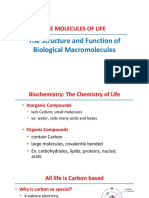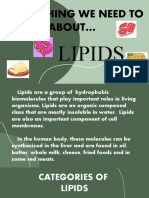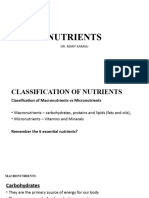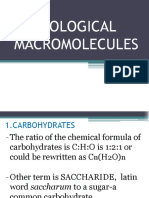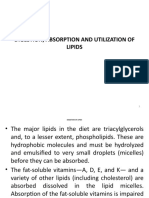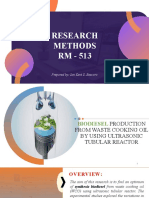0 ratings0% found this document useful (0 votes)
29 viewsLipidss (Autosaved)
Lipidss (Autosaved)
Uploaded by
ALipids are a diverse group of biomolecules that include fats, oils, waxes, sterols and phospholipids. They are insoluble in water but soluble in organic solvents. Lipids serve important structural and functional roles including energy storage, insulation, cellular signaling and as structural components of cell membranes. The basic building blocks of lipids are glycerol and fatty acids, which can combine to form triglycerides, the main constituents of fats and oils. Phospholipids also contain a phosphate group and are major components of cell membranes. Lipids undergo digestion, absorption, transport, and catabolism or biosynthesis as part of lipid metabolism in the body.
Copyright:
© All Rights Reserved
Available Formats
Download as PPTX, PDF, TXT or read online from Scribd
Lipidss (Autosaved)
Lipidss (Autosaved)
Uploaded by
A0 ratings0% found this document useful (0 votes)
29 views21 pagesLipids are a diverse group of biomolecules that include fats, oils, waxes, sterols and phospholipids. They are insoluble in water but soluble in organic solvents. Lipids serve important structural and functional roles including energy storage, insulation, cellular signaling and as structural components of cell membranes. The basic building blocks of lipids are glycerol and fatty acids, which can combine to form triglycerides, the main constituents of fats and oils. Phospholipids also contain a phosphate group and are major components of cell membranes. Lipids undergo digestion, absorption, transport, and catabolism or biosynthesis as part of lipid metabolism in the body.
Original Title
Lipidss [Autosaved]
Copyright
© © All Rights Reserved
Available Formats
PPTX, PDF, TXT or read online from Scribd
Share this document
Did you find this document useful?
Is this content inappropriate?
Lipids are a diverse group of biomolecules that include fats, oils, waxes, sterols and phospholipids. They are insoluble in water but soluble in organic solvents. Lipids serve important structural and functional roles including energy storage, insulation, cellular signaling and as structural components of cell membranes. The basic building blocks of lipids are glycerol and fatty acids, which can combine to form triglycerides, the main constituents of fats and oils. Phospholipids also contain a phosphate group and are major components of cell membranes. Lipids undergo digestion, absorption, transport, and catabolism or biosynthesis as part of lipid metabolism in the body.
Copyright:
© All Rights Reserved
Available Formats
Download as PPTX, PDF, TXT or read online from Scribd
Download as pptx, pdf, or txt
0 ratings0% found this document useful (0 votes)
29 views21 pagesLipidss (Autosaved)
Lipidss (Autosaved)
Uploaded by
ALipids are a diverse group of biomolecules that include fats, oils, waxes, sterols and phospholipids. They are insoluble in water but soluble in organic solvents. Lipids serve important structural and functional roles including energy storage, insulation, cellular signaling and as structural components of cell membranes. The basic building blocks of lipids are glycerol and fatty acids, which can combine to form triglycerides, the main constituents of fats and oils. Phospholipids also contain a phosphate group and are major components of cell membranes. Lipids undergo digestion, absorption, transport, and catabolism or biosynthesis as part of lipid metabolism in the body.
Copyright:
© All Rights Reserved
Available Formats
Download as PPTX, PDF, TXT or read online from Scribd
Download as pptx, pdf, or txt
You are on page 1of 21
LIPIDS
LIPIDS
• Derived from a greek word “lipos” means FAT
• are biomolecules that are insoluble in water, but are
soluble in non-polar solvents
• composed of basic element: carbon, hydrogen and
oxygen
• is also the body’s secondary source of energy at a rate of
9 cal/g.
• food sources such as butter, margarine, meat, eggs, milk,
cheese, vegetable oil, soy oil etc.
FUNCTIONS:
• play a vital role in many cellular processes including energy
storage, structural support, protection and communication
• accumulate in tissues around to act as insulation and
protection
• Cellular barriers that selectively allows molecules in and
out of the cells
• acting as hormones (steroid hormones)
FUNCTIONS:
• Lipid occur through out the living world in
microorganism, higher plants and animals and also in all
cell types.
• Lipids acts as important cellular metabolic regulators
• Lipids are compounds in inner mitochondrial membrane
and participate in Electron transport chain.
MONOMERS GLYCEROL & FATTY
ACIDS
• GLYCEROL is made up from three carbon atoms with a
Hydroxyl Group attached to it and hydrogen atoms occupying
the remaining positions.
• is an non-toxic compound and an alcohol composed of three
hydroxyl groups
• formula of glycerol is C3H8O3
• Used as a sweetener in drinks, often used as a solvent for food
colorings
GLYCEROL MOLECULAR STRUCTURE
FATTY ACIDS
• FATTY ACIDS consist of an carboxyl acid group (-COOH) at the end of chain at least 4
carbon atoms.
• They are nonpolar molecules and thus, insoluble in water but soluble in organic solvents.
Types of Fatty Acids:
• Saturated fatty acids – no bonds, melt at higher temperature, pack together easily so they
are harder to melt e.g. butter
• Atherosclerosis
• Unsaturated fatty acids– do contain bonds, melt at lower temperature, do not pack
together well so they are easier to melt e.g. olive oil
TRIGLYCERIDES
• are lipids consists of one glycerol molecule and three
fatty acids.
• The bonds between the molecules are covalent and are
called Ester bonds.
• Triglycerides are hydrophobic and so insoluble in water.
• E. g. fats and oils
PHOSPHOLIPIDS
• are similar to triglycerides in they consist of a glycerol
‘backbone’ and fatty acid ‘tails’, however the third fatty
acid has been replaced by a phosphate group.
• also have hydrophobic carbon chains and a hydrophilic
“head”.
• most important function –composing the lipid bilayer in
cell membranes
• are arranged so that all the hydrophilic (water-loving)
parts of molecule point outward and the hydrophobic
carbon chains point inward.
WAXES
FUNCTIONS:
• Provide protective barriers to prevent water loss and
protect cells
• Protect seeds and nutrients plant fruits and coat the
surface of plant leaves, forming a cuticle (layer of hard
skin) to prevent water loss.
• Prevent dehydration from body surfaces of many insects
STEROIDS
• are a class of lipids containing four connected
carbon rings.
• STEROID RINGS usually contain a few small
functional groups including hydroxyls (-OH) or
carboxyl (-COO).
• Cholesterol and other steroids containing a
hydroxyl group are called sterols.
FUNCTION:
• Steroid hormones such as ESTROGEN and
TESTERONE control reproductive processes and
development.
ROLE IN METABOLIC PROCESS
• LIPID METABOLISM is the synthesis and degradation
of lipids in cells, invoking the break down or strange of
fats for energy.
• These fats are obtained from consuming food and
absorbing them or they are synthesizing by an animals
liver.
STEP IN LIPID METABOLISM
• 1st Step: DIGESTION
process of breaking the triglyceridrs down into
smaller monoglycerides units with the help of lipid
enzymes
*lingual lipose – mouth
*gastric lipose – stomach
• 2nd Step: ABSORPTION OF FAT
occurs in the small intestine
• 3rd Step: TRANSPORTING LIPIDS
the cholesterol, they require special transport
proteins known as lipoproteins. The amphipathic structure of
lipoproteins allows the triglycerides and cholesterol to be
transported to the blood
• 4th Step: LIPID CATABOLISM
once the lipoproteins travel through the tissues, these
particles will be broken down by lipoprotein lipase in the
luminde surface of endothelial cells in capillaries to release
triglycerides
5th Step: LIPID BOSYNTHESIS
the dietary fats and storage lipids stored in the
adipose tissues are one of the main sources of energy for
living organisms. Triglycerides, lipid membranes and
cholesterol can be synthesized by the organisms through
various pathways.
You might also like
- Lecture 3 Structure and Function of Biological MoleculesDocument60 pagesLecture 3 Structure and Function of Biological MoleculesJuliana Bianca Dela VirgenNo ratings yet
- K. J. Saunders (Auth.) - Organic Polymer Chemistry - An Introduction To The Organic Chemistry of Adhesives, Fibres, Paints, Plastics and Rubbers-Springer Netherlands (1988) PDFDocument508 pagesK. J. Saunders (Auth.) - Organic Polymer Chemistry - An Introduction To The Organic Chemistry of Adhesives, Fibres, Paints, Plastics and Rubbers-Springer Netherlands (1988) PDFCarlos Alberto Ararat BermudezNo ratings yet
- 4lipids (INS)Document98 pages4lipids (INS)Fazl UllahNo ratings yet
- Lipids PowerpointDocument15 pagesLipids Powerpointapi-321789351100% (1)
- Physical Science Group4Document11 pagesPhysical Science Group4keahlacificar22No ratings yet
- Classification of LipidsDocument43 pagesClassification of Lipidsezechimaximillian2004No ratings yet
- Biochemistry - LipidsDocument33 pagesBiochemistry - Lipidslive scienceNo ratings yet
- Final LipidsDocument17 pagesFinal Lipidssamantha garciaNo ratings yet
- LIPIDS ReviewerDocument4 pagesLIPIDS ReviewermayiachiqtNo ratings yet
- On BiomoleculesDocument60 pagesOn BiomoleculesvpNo ratings yet
- 6atahir LipidsDocument83 pages6atahir LipidsshelwajaniNo ratings yet
- Biomolecules Lecture 1Document50 pagesBiomolecules Lecture 1sendpics.rhNo ratings yet
- SSGBIO1 - CM Week 4 - UpdatedDocument66 pagesSSGBIO1 - CM Week 4 - Updatedsgdick31No ratings yet
- Lipids (Jigsaw)Document33 pagesLipids (Jigsaw)Milimo JingsawNo ratings yet
- LIPIDS D PharmDocument65 pagesLIPIDS D PharmMadhuri poulkarNo ratings yet
- Chemistry of Lipids1-1Document31 pagesChemistry of Lipids1-1Anonymous mg7VXRNo ratings yet
- BIOMOLECULESDocument44 pagesBIOMOLECULESSarah SantiagoNo ratings yet
- The Structure and Function of MacromoleculesDocument106 pagesThe Structure and Function of Macromoleculesapi-259727482No ratings yet
- BIO100 Discoveries in Biology: Sustaining LifeDocument30 pagesBIO100 Discoveries in Biology: Sustaining LifenehalNo ratings yet
- Carbohydrates LipidsDocument15 pagesCarbohydrates LipidsEunice OlmedoNo ratings yet
- Digestion, Absorption and Metabolism of LipidsDocument34 pagesDigestion, Absorption and Metabolism of Lipidskijomip748No ratings yet
- 8.1 Biological MoleculesDocument134 pages8.1 Biological MoleculesHara Vienna ClivaNo ratings yet
- Lipids and CarbohydratesDocument27 pagesLipids and CarbohydratesbogattjeffNo ratings yet
- Group 3 - LipidsDocument22 pagesGroup 3 - Lipidsjohnpauloli0705No ratings yet
- LipidsDocument9 pagesLipidsroselh114No ratings yet
- Welcome To Class Of: LipidsDocument53 pagesWelcome To Class Of: LipidsMarinela DaumarNo ratings yet
- Lipids 1Document34 pagesLipids 1crystalghayleparrasNo ratings yet
- LipidsDocument34 pagesLipidsjohnphilipbacusNo ratings yet
- Sp14 10lipidsDocument20 pagesSp14 10lipidsqubituNo ratings yet
- LipidsDocument14 pagesLipidsPrincess Mary Icon MayolaNo ratings yet
- BIO 111 Lecture LIPIDSDocument40 pagesBIO 111 Lecture LIPIDSChileshe SimonNo ratings yet
- Lipids and Fatty AcidsDocument28 pagesLipids and Fatty AcidskaviyapriyaNo ratings yet
- BioChem - LipidsDocument41 pagesBioChem - LipidsKYLE ANDREW SAWITNo ratings yet
- Lipids (Fatty Acid and Glyceral)Document29 pagesLipids (Fatty Acid and Glyceral)madalisochisangaNo ratings yet
- LipidsDocument28 pagesLipidsbeabaigcr7eiqanNo ratings yet
- Lecture 1B. Introduction To BiochemistryDocument73 pagesLecture 1B. Introduction To BiochemistryAngella Reece IsraelNo ratings yet
- LipidsDocument30 pagesLipidsArnold C. LasitNo ratings yet
- Chapter 4 Lipids (Part I)Document50 pagesChapter 4 Lipids (Part I)wajeehgul400No ratings yet
- Experiment 5 LipidsDocument13 pagesExperiment 5 LipidsClemence Marie FuentesNo ratings yet
- Classificiation of LipdisDocument33 pagesClassificiation of LipdisArslan ShahNo ratings yet
- Lipids 1Document29 pagesLipids 17tn5g5dx9mNo ratings yet
- Chapter 5Document60 pagesChapter 5EhazNo ratings yet
- Biology Lipids PresentationDocument5 pagesBiology Lipids Presentationkaycee charlesNo ratings yet
- The Structure and Function of MoleculesDocument68 pagesThe Structure and Function of Moleculessesaeedhaniyah.dNo ratings yet
- BÃ I 5 Lipid (Version 1) (Compatibility Mode)Document49 pagesBÃ I 5 Lipid (Version 1) (Compatibility Mode)tranthilinhdannttNo ratings yet
- Lipids and Lipid MetabolismDocument73 pagesLipids and Lipid MetabolismAbegail LucapaNo ratings yet
- Week 3 - LipidsDocument32 pagesWeek 3 - LipidsNICOLE KAYE MANALANGNo ratings yet
- Biological+Macromolecules KalmaDocument40 pagesBiological+Macromolecules Kalmajudy andradeNo ratings yet
- LipidsDocument172 pagesLipidsK V SATHEESHKUMAR MECH100% (1)
- LipidsDocument44 pagesLipidsikramullahkhangamingNo ratings yet
- Nutrients - M.K.Document61 pagesNutrients - M.K.goodfetch87No ratings yet
- Biological MacromoleculesDocument103 pagesBiological MacromoleculesEuniceNo ratings yet
- LIPIDSDocument8 pagesLIPIDSmkuuspoilerNo ratings yet
- Lipids Unza (Jigsaw)Document31 pagesLipids Unza (Jigsaw)LUNARNo ratings yet
- Lipids Unza (Jigsaw)Document31 pagesLipids Unza (Jigsaw)LUNARNo ratings yet
- Mls 311 Lecture Notes 4Document28 pagesMls 311 Lecture Notes 4CoffeeswanNo ratings yet
- Chemistry of SIMPLE Lipids.Document49 pagesChemistry of SIMPLE Lipids.QueenNo ratings yet
- Group 1 LipidsDocument7 pagesGroup 1 Lipidsabalos.chianjoaquin.hNo ratings yet
- Digestion, Absorption and Utilization of LipidsDocument15 pagesDigestion, Absorption and Utilization of LipidsBalram NeupaneNo ratings yet
- Metabolism of FatDocument8 pagesMetabolism of Fatonkars2112No ratings yet
- Anatomy and Physiology for Students: A College Level Study Guide for Life Science and Allied Health MajorsFrom EverandAnatomy and Physiology for Students: A College Level Study Guide for Life Science and Allied Health MajorsNo ratings yet
- A AFA GRADE 8 Q1M7 Teacher Copy TLE Final LayoutDocument30 pagesA AFA GRADE 8 Q1M7 Teacher Copy TLE Final LayoutMerjulyn AsilumNo ratings yet
- Common and IUPAC Names of Some Organic CompoundsDocument6 pagesCommon and IUPAC Names of Some Organic Compoundskalpit agrawalNo ratings yet
- 5409 16570 1 PBDocument3 pages5409 16570 1 PBShinta VivinNo ratings yet
- Details For Black BookDocument62 pagesDetails For Black BookSagar PatilNo ratings yet
- Hydrogels of Used Disposable Diapers As Organic Fertilizer For The Growth of MonggoDocument21 pagesHydrogels of Used Disposable Diapers As Organic Fertilizer For The Growth of MonggoJhana MikaelaNo ratings yet
- L2 (RXN Mech) SN2Document59 pagesL2 (RXN Mech) SN2ydouneed2012No ratings yet
- UP-Lec 6-Rev11Document28 pagesUP-Lec 6-Rev11HASSAN ABBAS CHEEMANo ratings yet
- Spojke Plosnati Remen Klinasti Remen Zupčasti Remen Lančani PrijenosDocument27 pagesSpojke Plosnati Remen Klinasti Remen Zupčasti Remen Lančani PrijenosKarlo KlobučarićNo ratings yet
- Saudi Journal of Biological Sciences: Original ArticleDocument10 pagesSaudi Journal of Biological Sciences: Original ArticlejafarNo ratings yet
- Pharmaceutical Product DevelopmentDocument29 pagesPharmaceutical Product DevelopmentArthiNo ratings yet
- EN LIPASE BAOSR6x30Document3 pagesEN LIPASE BAOSR6x30محمد عبدالواسعNo ratings yet
- Astm D 974Document7 pagesAstm D 974Jherson Ariza GarciaNo ratings yet
- Improved Sample Storage, Preparation and Extraction of Blueberry AromaDocument8 pagesImproved Sample Storage, Preparation and Extraction of Blueberry AromaPamela GuittinsNo ratings yet
- Organic Chemistry - Lec4 (Heterocyclic Compound)Document34 pagesOrganic Chemistry - Lec4 (Heterocyclic Compound)ayots219No ratings yet
- Zepoxy REH 205Document2 pagesZepoxy REH 205Aahsan Iqbal احسن اقبالNo ratings yet
- 20 PDFDocument82 pages20 PDFWalid EbaiedNo ratings yet
- Chemistry and Pharmacology of Piper Longum L: ArticleDocument11 pagesChemistry and Pharmacology of Piper Longum L: ArticleMuhammad Maulana SidikNo ratings yet
- Metal Organic Frameworks For Food SafetyDocument53 pagesMetal Organic Frameworks For Food SafetyCaroline MeinertNo ratings yet
- Guide No01 GRLs7th Issue Oct21Document13 pagesGuide No01 GRLs7th Issue Oct21hüseyinNo ratings yet
- Product Range - Morocco - Nov 2022Document24 pagesProduct Range - Morocco - Nov 2022Ahmed EL HAJJAJINo ratings yet
- Biopolymers From Waste Valorization Nutracos 2015Document5 pagesBiopolymers From Waste Valorization Nutracos 2015EL Hassania EL HERRADINo ratings yet
- 10.haloalkanes and Haloarenes KCET PYQsDocument1 page10.haloalkanes and Haloarenes KCET PYQseshasingh2007No ratings yet
- Biodiesel Production Through Waste Cooking OilDocument15 pagesBiodiesel Production Through Waste Cooking OilYan's Senora BescoroNo ratings yet
- Preliminary Phytochemical Analysis of Different Extracts of Ruellia Patula Laegyptiaca and Thunbergia AlataDocument6 pagesPreliminary Phytochemical Analysis of Different Extracts of Ruellia Patula Laegyptiaca and Thunbergia AlataleimonNo ratings yet
- Extrusion Compounding Process For The Development of Eco-Friendly SCG/PP Composite PelletsDocument12 pagesExtrusion Compounding Process For The Development of Eco-Friendly SCG/PP Composite PelletsVirendra RathvaNo ratings yet
- Molecules 28 03379 v2Document61 pagesMolecules 28 03379 v2Pratap ShettyNo ratings yet
- Daftar Harga PT - Enseval Medika Prima 2003Document7 pagesDaftar Harga PT - Enseval Medika Prima 2003umarNo ratings yet
- Formulation and Evaluation of Herbal Hair Dye A ReDocument20 pagesFormulation and Evaluation of Herbal Hair Dye A ReHector Santiago Lopez AcostaNo ratings yet
- IX - Pollution NoteDocument5 pagesIX - Pollution NoteAnjuJohnNo ratings yet
